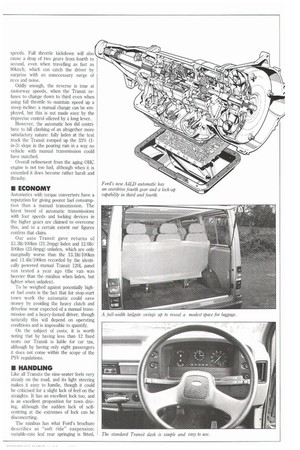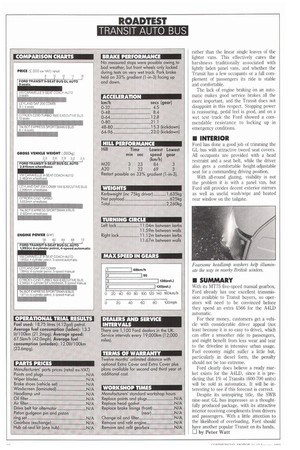ROADTEST TRANSIT AUTO BUS
Page 54

Page 55

Page 56

If you've noticed an error in this article please click here to report it so we can fix it.
It was designed for the Sierra and Granada saloon car families and follows modern passenger vehicle practice by incorporating features intended to give the fuelconsumption benefits of a five-speed manual gearbox. As its designation implies, these include an overdriven fourth gear, and a device to lock the torque converter in the top two gears.
The basic layout is that of a conventional automatic, with a torque converter driving an epicyclic gearbox under hydraulic control. The main differences are that a friction clutch is inserted between the converter cover and the converter turbine to provide luck-up in third and fourth, and an extra planetary gear set is positioned between the converter and the main gearbox for the overdrive ratio.
The transmission takes its cue to change gear from inputs for engine and road speed, selector position and engine load. The kickdown (which causes the gearbox to change down when sudden acceleration is required) is now triggered by an electrical switch rather than a mechanical sensor on the throttle.
The long 1-handle control moves through a quadrant in the normal ParkReverse-Neutral-Drive-3-2-1 sequence: the lever passes its instructions to the gearbox via a cable.
In contrast to the new gearbox, the The interior of the GL nine-seater is attractively trimmed with carpets and tweed seat coverings; a step makes entry and exit much easier. engine driving it is Ford's rather tired 1,993cc OHC unit, which has been replaced in its cars by a new DOHC engine. With the low (8.1:1) compression ratio it produces a modest 57kW (77hp) at 4,500rpm with 147Nm (1081bft) at 2,800rpm and runs on unleaded fuel without adjustment.
The A4LD's box, incidentally, differs from its predecessor by being engineered to accept Ford's 2.5-litre DI diesel, a combination which might be preferable for those who value fuel economy over refinement.
• PERFORMANCE
Grab hold of the long gear stick, slip the transmission into D, and take on some rush-hour city traffic, and it will not take long to convince you that there is a definite place for the self-shifting gearbox.
Accelerate away and the A4LD box moves sweetly and quickly between ratios, with the change-up points being largely determined by road speed and throttle position; the long-striding overdrive fourth is not called upon very much around town, and generally drops in above 70Iun/h on the open road.
The only small quirk possessed by the transmission is a slight over-eagerness to drop down a gear when called upon to accelerate gently at particular road speeds. Full throttle kickdown will also cause a drop of two gears from fourth to second, even when travelling as fast as 80kmih, which can catch the driver by surprise with an unnecessary surge of revs and noise.
Oddly enough, the reverse is true at motorway speeds, when the Transit refuses to change down to third even when using full throttle to maintain speed up a steep incline; a manual change can be employed, but this is not made easy by the imprecise control offered by a long lever.
However, the automatic box did contribute to hill climbing of an altogether more satisfactory nature: fully laden at the test track the Transit romped up the 33% (1in-3) slope in the pouring rain in a way no vehicle with manual transmission could have matched.
Overall refinement from the aging OHC engine is not too bad, although when it is extended it does become rather harsh and thrashy.
• ECONOMY
Automatics with torque converters have a reputation for giving poorer fuel consumption than a manual transmission. The latest breed of automatic transmissions with four speeds and locking devices in the higher gears are claimed to overcome this, and to a certain extent our figures confirm that claim.
Our auto Transit gave returns of 13.3lit/100km (21.2mpg) laden and 12.01it/ 100km (23.6mpg) unladen, which are only marginally worse than the 13.11it/100km and 11.41it/100km recorded by the identically powered manual Transit 120L panel van tested a year ago (the van was heavier than the minibus when laden, but lighter when unladen).
To be weighed against potentially higher fuel costs is the fact that for stop-start town work the automatic could save money by avoiding the heavy clutch and driveline wear expected of a manual transmission and a heavy-footed driver, though naturally this will depend on operating conditions and is impossible to quantify.
On the subject of costs, it is worth noting that by having less than 12 fixed seats our Transit is liable for car tax, although by having only eight passengers it does not come within the scope of the PSV regulations.
• HANDLING
Like all Transits the nine-seater feels very steady on the road, and its light steering makes it easy to handle, though it could be criticised for a slight lack of feel on the straights. It has an excellent lock too, and is an excellent proposition for town driving, although the sudden lack of selfcentring at the extremes of lock can be disconcerting.
The minibus has what Ford's brochure describes as "soft ride" suspension: variable-rate leaf rear springing is fitted, rather than the linear single leaves of the lighter vans. This effectively cures the harshness traditionally associated with lightly laden panel vans, and whether the Transit has a few occupants or a full complement of passengers its ride is stable and comfortable.
The lack of engine braking on an automatic makes good service brakes all the more important, and the Transit does not disappoint in this respect. Stopping power is reassuring, pedal feel is good, and on a wet test track the Ford showed a commendable resistance to locking up in emergency conditions.
• INTERIOR
Ford has done a good job of trimming the GL bus with attractive tweed seat covers. All occupants are provided with a head restraint and a seat belt, while the driver also gets a comfortable height-adjustable seat for a commanding driving position.
With all-round glazing, visibility is not the problem it is with a panel van, but Ford still provides decent exterior mirrors as well as useful wash/wipe and heated rear window on the tailgate.
• SUMMARY
With its MT75 five-speed manual gearbox, Ford already has one excellent transmission available to Transit buyers, so operators will need to be convinced before they spend an extra 566 for the A4LD automatic.
For their money, customers get a vehicle with considerable driver appeal (not least because it is so easy to drive), which can offer a smoother ride to passengers, and might benefit from less wear and tear to the driveline in intensive urban usage. Fuel economy might suffer a little but, particularly in diesel form, the penalty should not be too extreme.
Ford clearly does believe a ready market exists for the A4LD, since it is predicting that 1% of Transits (600-700 units) will be sold as automatics. It will be interesting to see if this forecast is correct.
Despite its uninspiring title, the SWE nine-seat GL bus impresses as a thoughtfully produced package, with its attractive interior receiving compliments from drivers and passengers. With a little attention to the likelihood of overloading, Ford should have another popular Transit on its hands.
O by Peter Watt
















































































































